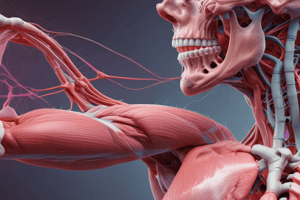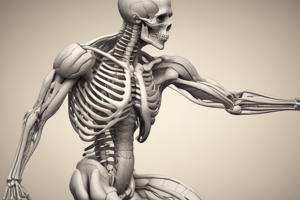Podcast
Questions and Answers
Which characteristic allows muscle tissue to return to its original length after being stretched?
Which characteristic allows muscle tissue to return to its original length after being stretched?
- Extensibility
- Contractility
- Excitability
- Elasticity (correct)
Which of the following is an accurate description of 'excitability' in the context of muscle physiology?
Which of the following is an accurate description of 'excitability' in the context of muscle physiology?
- The ability to stretch beyond its resting length
- The property of returning to original shape after being stretched
- The capability to respond to stimuli (correct)
- The capacity to shorten forcefully when stimulated
How does skeletal muscle contribute to heat production in the body?
How does skeletal muscle contribute to heat production in the body?
- By insulating the body and preventing heat loss
- By converting chemical energy into kinetic energy with 100% efficiency
- Through metabolic processes that generate heat as a byproduct (correct)
- By actively transporting heat from the core to the surface of the body
What is the role of a motor unit in muscle contraction?
What is the role of a motor unit in muscle contraction?
Which of the following accurately describes the arrangement at the neuromuscular junction?
Which of the following accurately describes the arrangement at the neuromuscular junction?
What is the direct result of acetylcholine binding to receptors on the post-synaptic sarcolemma?
What is the direct result of acetylcholine binding to receptors on the post-synaptic sarcolemma?
What propagates the action potential from the sarcolemma into the inner regions of the muscle fiber?
What propagates the action potential from the sarcolemma into the inner regions of the muscle fiber?
What is the initial step that activates the myosin head?
What is the initial step that activates the myosin head?
How does the release of calcium from the sarcoplasmic reticulum directly facilitate muscle contraction?
How does the release of calcium from the sarcoplasmic reticulum directly facilitate muscle contraction?
What event is directly triggered by an action potential in the T tubules?
What event is directly triggered by an action potential in the T tubules?
What is the role of ATP in the detachment of myosin from actin?
What is the role of ATP in the detachment of myosin from actin?
What happens to calcium levels in the sarcoplasm if a muscle fiber is to continue contracting?
What happens to calcium levels in the sarcoplasm if a muscle fiber is to continue contracting?
How does the length of the A band change during muscle contraction according to the sliding filament mechanism?
How does the length of the A band change during muscle contraction according to the sliding filament mechanism?
Following the power stroke, what causes the myosin head to detach from actin?
Following the power stroke, what causes the myosin head to detach from actin?
Which event directly follows the depolarization of the sarcolemma?
Which event directly follows the depolarization of the sarcolemma?
What is the primary function of the sarcoplasmic reticulum in muscle contraction?
What is the primary function of the sarcoplasmic reticulum in muscle contraction?
How does the troponin-tropomyosin complex regulate muscle contraction?
How does the troponin-tropomyosin complex regulate muscle contraction?
During the cross-bridge cycle, what causes the release of ADP and inorganic phosphate from the myosin head?
During the cross-bridge cycle, what causes the release of ADP and inorganic phosphate from the myosin head?
What structural changes occur in the sarcomere during muscle contraction?
What structural changes occur in the sarcomere during muscle contraction?
Which of the following allows the muscle to shorten?
Which of the following allows the muscle to shorten?
Flashcards
Excitability (Muscle)
Excitability (Muscle)
The ability of muscle tissue to receive and respond to stimuli.
Contractility (Muscle)
Contractility (Muscle)
The ability of muscle tissue to shorten and thicken, generating force.
Extensibility (Muscle)
Extensibility (Muscle)
The ability of muscle tissue to stretch without being damaged.
Elasticity (Muscle)
Elasticity (Muscle)
Signup and view all the flashcards
Fascicle
Fascicle
Signup and view all the flashcards
Sarcolemma
Sarcolemma
Signup and view all the flashcards
Motor End Plate
Motor End Plate
Signup and view all the flashcards
Neuromuscular Junction (NMJ)
Neuromuscular Junction (NMJ)
Signup and view all the flashcards
Motor Unit
Motor Unit
Signup and view all the flashcards
Synaptic Cleft
Synaptic Cleft
Signup and view all the flashcards
Acetylcholine (ACh)
Acetylcholine (ACh)
Signup and view all the flashcards
End Plate Potential (EPP)
End Plate Potential (EPP)
Signup and view all the flashcards
Tropomyosin
Tropomyosin
Signup and view all the flashcards
Troponin
Troponin
Signup and view all the flashcards
Sliding Filament Mechanism
Sliding Filament Mechanism
Signup and view all the flashcards
Sarcomere
Sarcomere
Signup and view all the flashcards
Study Notes
- Lecture 11 covers Skeletal Muscle Physiology I, Chapter 10.
Skeletal System Physiology
- Key characteristics of muscle tissue include excitability, contractility, extensibility, and elasticity.
- Excitability refers to the ability to respond to stimuli.
- Contractility refers to the ability to shorten and thicken.
- Extensibility refers to the ability to be stretched when pulled.
- Elasticity refers to the ability to return to its original shape after contraction or extension.
Skeletal Muscle Function
- Key functions of skeletal muscle:
- Movement, like walking, breathing, and talking.
- Heat production, where heat comes as a waste product of metabolism in muscle fibers.
- Posture and facial expression.
- Visceral protection via abdominal muscles.
The Neuromuscular Junction
- A single muscle fiber is innervated by a single neuron.
- The axon of a motor neuron branches to innervate multiple muscle fibers.
- A motor unit includes one motor neuron and all the muscle fibers it innervates.
- One neuron can stimulate up to 150 muscle fibers within the same muscle, such as the biceps.
- All muscle fibers within a motor unit contract together.
- Motor units are distributed throughout a large muscle.
- The pre-synaptic neuron at the neuromuscular junction contains vesicles filled with acetylcholine.
- The post-synaptic cell is a muscle fiber, its sarcolemma contains acetylcholine receptors and is called the motor end plate.
- The synaptic cleft separates the pre-synaptic lower motor neuron from the post-synaptic muscle fiber.
Signal Transmission
- The action potential reaches the axon terminal and synaptic end bulb and results in exocytosis of acetylcholine.
- Calcium enters through voltage gates, triggering acetylcholine release.
- Acetylcholine binds to receptors on the post-synaptic sarcolemma at the motor end plate.
- Chemically gated sodium channels open in response to acetylcholine binding, producing a depolarizing end plate potential (EPP).
- The EPP is a graded potential that causes voltage-gated sodium channels to open on the adjacent sarcolemma, initiating an action potential in the muscle fiber.
- The action potential in the muscle fiber has the same properties as an action potential in a neuron.
- An action potential in a lower motor neuron always causes an action potential in the muscle fiber due to the large amount of acetylcholine released and high concentration of acetylcholine receptors.
- Inhibition of the lower motor neuron is necessary to prevent skeletal muscle contraction.
Contraction of Skeletal Muscle
- Tropomyosin covers myosin binding sites on actin filaments when the muscle is relaxed.
- The myosin head must be activated before contraction occurs.
- Once activated, the myosin head is ready to bind to myosin binding sites as soon as a stimulus arrives.
- Activation of the myosin head involves ATP converting to ADP + Pi + energy.
- The energy released from ATP breakdown is stored in the myosin head and later used for contraction.
- The sarcolemma is depolarized by the influx of sodium, creating an EPP, which leads to an action potential (AP).
- The action potential spreads down the T-tubules, penetrating deep into the muscle fiber.
- Excitation-contraction coupling links the electrical event of the action potential to the contractile event in the muscle fiber.
- The action potential in the T tubules triggers the release of calcium from the terminal cisternae of the sarcoplasmic reticulum through mechanically gated calcium channels.
- Calcium ions released bind to troponin.
- The troponin-tropomyosin complex shifts position, exposing the myosin binding sites on the actin filaments.
- Activated myosin heads attach to the newly exposed myosin binding sites on actin, forming cross-bridges.
- Energy stored in the myosin head is released as the myosin head pivots, creating the power stroke.
- ADP and Pi are released from the myosin head following the power stroke.
- The power stroke causes the actin filament to slide over the myosin filament, moving toward the center of the sarcomere, which is known as the sliding filament mechanism.
- A new molecule of ATP then attaches to the myosin head.
- ATP binding causes the myosin head to detach from the myosin binding sites on actin.
- The myosin head reactivates by converting ATP into ADP and Pi.
- The energy released is once again stored in the myosin head, ready for the next contraction event.
- If calcium levels remain high in the sarcoplasm, calcium will continue to bind to troponin.
- Activated myosin heads will continue to bind to actin, causing filaments to slide.
- ATP will attach to myosin, causing the myosin to be released from the actin, and the myosin head will reactivate.
- This cycle continues, resulting in the shortening of the muscle.
- During the sliding filament mechanism, sarcomeres shorten.
- The H zone and the I band become shorter.
- The A band does not change length.
- The myofibrils shorten, leading to shortening of the whole fiber.
- The length of thin (actin) and thick (myosin) filaments remains the same during this process.
Studying That Suits You
Use AI to generate personalized quizzes and flashcards to suit your learning preferences.




